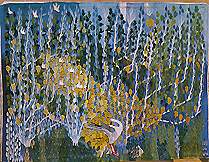|
FIRST
GENERATION WEAVERS
 Village
in Harmony - 1990
Village
in Harmony - 1990 |
Ramses
and Sophie began their work at Harrania in 1952 with just
a dozen or so children. These later became known as the "first
generation" weavers. Although at first more girls than boys
were attracted to the craft, eventually boys also joined the
group.
From
the beginning, Ramses knew just what was needed for these
children in their development as successful weavers. While
they learned the practical side of the craft, an important
concern for him was also to stimulate their imagination. In
order to achieve this, he and Sophie often took them on outings
to the banks of the Nile, the palm groves, the city, the zoo,
the desert and. even as far as Alexandria so that they could
experience the sea. Ramses believed that, "For
a child, the image is the vehicle of his emotions, a reflection
of his inner life. It is just as natural for him to express
himself in pictures as in words, which for him are merely
a series of linked images."
As
a result of their experiences with the Wissa Wassefs, in a
relatively short period of time, an abundance of images began
to appear on the weavers' looms. As the children explored
and mastered weaving techniques, their expressions became
bolder and individual styles began to emerge. All of them
however seemed to focus their thoughts on the village life
around them.
|

|
When
one considers the mechanics of producing these works, one
is instantly astonished to find that the whole composition
is conceived purely in the mind of the weaver. Both adults
and children work seated in front of the loom and as each
new piece is finished; it is rolled out of view. This means
that the weaver never sees the complete design until the tapestry
is finished. It is interesting to note, that an experienced
adult weaver may produce a maximum of 15 square meters a year.
Sophie
Wissa Wassef comments on the weavers. "All
our artists have a clear vision of their own world. Aesthetic
expression does not come just from what the eye sees, but
from everything one feel, clearly or confusedly. Once when
a weaver saw one of his large panels hung up for the first
time, after he had been working on it for a year, he said,
as if he were waking up from a dream, 'Did I do all that?'
"
It
was after several years of dedicated patience that the works
of the first generation were first put on display. Since then
exhibitions of the Wissa Wassef tapestries have been held
regularly in numerous countries.
 Grapes
- 1977
Grapes
- 1977 |
Many
of them now grace the walls of galleries, and are found in
private collections around the world. The first generation
weavers have come a long way on their journey. Through their
work they have become sophisticated artists capable of subtle
color and fine shading. One element in particular seems to
have endured through time and remains an important aspect
of their craft. Found woven into the tapestries are the transforming
themes of nature - surely a reflection of life at Harrania
- the heart and home of the weavers.
|
|